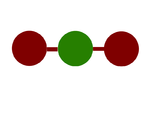Danio
Newbie level 2

- Joined
- Sep 1, 2013
- Messages
- 2
- Helped
- 0
- Reputation
- 0
- Reaction score
- 0
- Trophy points
- 1
- Location
- Delft
- Activity points
- 25
I am designing a device that operates in the ISM band (2.4-2.48) for which omnidirectionality and size are important. The device has a cylindrical shape, with a stack of battery, PCB and speaker (in that order). This makes the placement of the antenna tricky: in the center on the PCB the signal will be blocked by the speaker and battery, and letting the PCB extend beyond the speaker and battery (in diameter) is not possible. So, the solution I have so far: the PCB is a flex PCB consisting of three circles. The center one is the normal PCB part, the two other circles contain the antenna. One of those folds on top of the battery-PCB-speaker stack, and one to the bottom. This way the signal isn't blocked and should be rather omnidirectional. A sketch of this PCB is attached.

But, now the design of the antenna itself. What I have now: on the PCB the RF signal is created. This signal is put on a PCB trace with a length of about 1 lamba to the top circle and 1 lambda to the bottom circle. The circles all have a diameter of 20mm, so on the top and bottom circle these traces meander a bit. I simulated this contraption in CST, but the best S parameter I get is -6dB. the omnidirectionality is pretty good though. I expect that this can be improved, but I have very little experience with antenna design, and because this antenna consists of two parts (one to the top and one to the bottom with the feed in the middle), I'm not sure how to use a different of the shelf solution. Who has a better idea?

But, now the design of the antenna itself. What I have now: on the PCB the RF signal is created. This signal is put on a PCB trace with a length of about 1 lamba to the top circle and 1 lambda to the bottom circle. The circles all have a diameter of 20mm, so on the top and bottom circle these traces meander a bit. I simulated this contraption in CST, but the best S parameter I get is -6dB. the omnidirectionality is pretty good though. I expect that this can be improved, but I have very little experience with antenna design, and because this antenna consists of two parts (one to the top and one to the bottom with the feed in the middle), I'm not sure how to use a different of the shelf solution. Who has a better idea?

